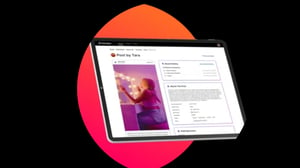If you're a marketer working with creators, you've probably had that moment — 2 a.m., staring at the ceiling, suddenly wondering, "Wait...do we actually own the rights to that video we boosted for our holiday campaign? Can we still use it next month? What if we want to turn it into a YouTube ad?"
Welcome to the world of influencer content usage rights. It's one of the least sexy but most important aspects of influencer marketing, and it’s the thing that could quietly derail your best-performing content if you're not careful.
Usage rights have become increasingly important as influencer marketing matures. Brands are moving away from broad or perpetual agreements and instead seeking tailored, flexible terms that align more closely with their strategic objectives and specific campaign lifecycles.
“One way of scaling is through rights,” notes Richelle Batuigas, VP of Business Intelligence & Data Strategy at Viral Nation. “If you have an asset you've contracted with the creator, negotiate rights and put it on every touchpoint.”
By negotiating the right usage terms upfront, marketers can extend the reach of top-performing assets, reduce production costs, and get more from every campaign touchpoint.
Defining Usage Rights and Types to Negotiate
Usage rights are the permissions you negotiate with an influencer or creator that outline how, where, and for how long you can use the content they produce for your brand. These rights are often the difference between running a single campaign and building an entire cross-channel strategy from one high-performing asset.
At a minimum, usage rights should answer questions like:
- Which platforms can this content appear on?
- Is it for the influencer’s feed only, or can it live on brand-owned channels too?
- How long is the content licensed for?
- Is the content approved for paid media use?
- Can it be edited or reused across formats?
- Are you licensing the content or taking full ownership?
Spoiler: if it’s not spelled out in the contract, the answer is probably no, and a renegotiation will be required which will drive up costs for the brand.
Here are the five main types of rights every marketer should understand:
1. Organic Usage Rights
This is the most basic level of usage. The content lives on the influencer’s channel and the brand typically does not own or reuse it elsewhere. You’ve paid for the post, not the asset.
Why it matters: Once the content fades from the feed, it’s gone. If it performs well, you have no way to extend its reach or re-use it unless you renegotiate.
2. Whitelisting / Paid Media Usage
This allows brands to run paid ads using the influencer’s content, either through the creator’s handle or their own. This type of content often outperforms brand-created assets in paid placements because it feels native and relatable.
Why it matters: Without this, you can't amplify creator content through paid channels. That limits your ability to scale what’s already working.
3. Usage on Brand-Owned Channels
This includes reposting content to your own social feeds, embedding it on a website, adding it to a newsletter, or using it in internal decks. These rights help brands stretch content across touchpoints without creating new assets from scratch.
Why it matters: You get more mileage from the content and add social proof to your owned platforms without doubling your production workload.
4. Timeframe of Usage Rights
How long the content can be used—30 days, 3 months, 1 year, or more—makes a big difference to cost and flexibility. Some creators are fine with unlimited usage, others charge more or ask for limited durations. It’s also important to clarify if the time period starts from when the content goes live, or from the campaign’s start date.
Why it matters: Misaligned timeframes can stall campaigns or trigger unexpected costs. Rights that expire mid-campaign can force you into rushed renegotiations.
5. Derivative Works
This refers to whether a brand can make edits to the content. That could mean trimming a video, adding a voiceover, changing music, or creating a montage. Many creators want final approval on these changes. To avoid delays, brands can negotiate pre-approval or waive approval requirements in the contract.
Why it matters: Repurposing high-performing content is only possible if your agreement allows it. Without this, your hands are tied creatively and strategically.
As Chloe Morris, Head of Creator Relations at Viral Nation, puts it: “Flexible usage rights also allow creators to safeguard their image.”
Being specific about rights helps both parties. The creator knows what they’re agreeing to. The brand knows exactly how the content can be used, where, and for how long. The clearer the contract, the smoother the campaign.
Why Usage Rights Shouldn’t Be an Afterthought
Let’s say you’ve launched a killer campaign. Engagement is through the roof. You want to scale it with paid. But your agreement only covered organic usage for 30 days.
Now what?
You go back to the creator. They know the content is performing. Suddenly, the cost to extend usage or whitelist that content has doubled or tripled—or worse, they decline.
So now you’re stuck:
- Creating new content (time-consuming and expensive)
- Settling for lower-performing assets
- Explaining to your boss why the “top performer” disappeared from the campaign
This kind of scenario isn’t rare. When usage rights are treated as an afterthought, it shows up in all the worst ways—costly renegotiations, missed opportunities, and, in some cases, full-blown legal battles.
Take the 2022 case of a beauty brand that used an influencer's Instagram image in-store displays without permission. The original agreement only covered one photo and one video, yet the brand pulled a different post and used it nationwide. The result? A $40,000 legal demand, followed by a lawsuit for misappropriation of likeness.
Or consider the Sony Music vs. OFRA Cosmetics case from 2023. Influencers in OFRA's campaign used songs owned by Sony in hundreds of promotional TikToks and Instagram videos. Sony sued, claiming copyright infringement—and pointed fingers not just at the creators, but at the brand that reposted the content. This wasn’t just a usage issue about photos. It was a reminder that music and third-party IP in influencer content are just as risky when rights aren't cleared.
Even brand events can trigger issues. One influencer discovered her photo booth image from an event plastered across a massive billboard—something she hadn’t explicitly agreed to. Turns out the brand had slipped a waiver into the booth's terms and conditions. No lawsuit followed, but it served as a cautionary tale: fine print isn’t enough. Transparency matters.
Each of these examples reflects what happens when there’s a gap between the rights you think you have and the ones you’ve actually secured.
Marketers often plan to amplify great content across channels, but without the right terms in place, they face unexpected costs or content takedowns. Creators now regularly charge more for extended or multi-platform rights—sometimes doubling or tripling their base rates. One mid-tier influencer disclosed being paid over $20,000 just for a three-year usage extension.
And the fallout isn’t always financial. Reputation matters. Creators talk. If they feel a brand overstepped, it can hurt your long-term relationships—or even get called out publicly.
Getting usage rights wrong can turn your best-performing content into a liability. Getting it right keeps your campaigns running smoothly and your partnerships strong.
Legal Insights and Best Practices
Usage rights aren't just a marketing concern. They’re rooted in intellectual property law, licensing agreements, and publicity rights. Brands that treat influencer content like media assets and secure the right legal coverage upfront can avoid most of the pitfalls.
Influencer content is owned by the creator by default. That means the brand needs explicit permission to reuse, repost, or repurpose it. “In influencer marketing, the influencer owns the rights to their content and the brand has to be granted, or purchase, those rights,” says Amanda Schreyer, a digital media attorney.
To avoid ambiguity, marketers should ensure every influencer contract includes a content usage clause that spells out:
- What the content is (photo, video, story, etc.)
- Where it can be used (owned social, paid, email, OOH, etc.)
- How long it can be used for (with renewal terms defined)
- Whether the content can be edited, remixed, or rebranded
- Whether rights are exclusive or non-exclusive
- Whether the influencer grants rights to their name, likeness, or handle
Top brands also build internal systems to manage usage rights:
- Use vetted legal contract templates
- Track licenses and usage windows in a central database
- Set alerts when rights are about to expire
- Share terms clearly across marketing, PR, and paid teams
Legal protection should also cover third-party content used in influencer posts—especially music. As the Sony case showed, failing to license music can lead to lawsuits. Brands can audit content before publishing or require creators to use royalty-free assets.
And finally, fair partnerships matter. Transparent negotiation, fair compensation for extended rights, and clear expectations go a long way. When creators feel respected, they’re more open to renewals and broader usage terms.
Simplify Influencer Licensing and Content Rights with Viral Nation
As influencer marketing matures, so should the way brands think about contracts, licensing, and usage rights. If content is the new currency, usage rights are the vault key.
If a creator’s post is driving results, the real question isn’t just how well it performed—it's whether you have the ability to use it again, amplify it, or repurpose it down the line. If the answer is no—or you’re unsure—it might be time to revisit your agreements and how you structure creator partnerships.
This isn’t just about protecting your investment. It’s about unlocking more value from the content you’re already paying for.
Viral Nation helps brands navigate every stage of influencer marketing—including the fine print. From campaign planning to contract negotiation, our team ensures you’re set up to scale content that performs—without getting tripped up by usage limitations. Our end-to-end influencer marketing services, combined with brand safety tools like Secure™, provide the infrastructure to manage content rights effectively and maximize ROI.
Because sleep is great. But knowing every asset in your creator campaign is fully licensed, legally sound, and ready to work harder across every channel? That’s even better.





.png?width=96&height=96&name=Modern%20and%20Inviting%20Bariatric%20Banter%20Podcast%20Logo%20(2).png)
